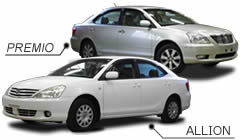TOYOTA ALLION VS TOYOTA PREMIO - Vol.161
Japanese auto manufacturer Toyota released the Toyota Premio as a sedan. It was traded in Japan by Toyota as selected by Japanese regulations with regards to exterior proportions and engine reactions.
When compared to the Toyota Allion, the Premio is an upmarket luxury sedan. The Allion featured a more young and sporty nature and is also akin to the Toyota Avensis, traded exclusively by Toyota Netz auto traders. The Toyota Premio is selective to Japanese Toyota dealers Toyopet Store. The Toyota Premio and the Allion were manufactured and released over the same period.

Wood trim and silver detail provides the Premio with a graceful appearance and it is regarded to be a family or executive category sedan. Appearance enhancement options available to the Toyota Allion are not presented or endorsed for the Toyota Premio.
When referring to class, the Premio is planned to function as a secondary alternative to the Toyota Camry.
Toyota Premio First Phase T24 series (2001-2006)
The Toyota Premio succeeded the Toyota Corona as well as the Corona Premio. The first phase Premio was released during December 2001. It was presented in three engine variations; 1.5L, 1.8L and the 2.0L. In 2005, the Premio received a slight modification which is most noticeable in the modern brake lights.
Toyota Premio Second Phase T26 series (2007-Present)
The second phase Toyota Premio hit the auto market in 2007. It continues to occupy the market opening between the Toyota Corolla and the Toyota Camry. It has a more high-priced appearance with alterations conducted to the front bumper, radiator framework and headlamp assembly. The most substantial modification was the fitting of a LED inside the rear lamp assembly.
The Allion is a sedan traded in Japan by Toyota. It has a young, sleek appearance as the Toyota Allion is aimed towards a younger target group. The Allion is solely traded by Japanese Toyota auto traders. As is the case with the Toyota Premio, the Allion is also akin to the Toyota Avensis. The name "Allion" was created as derived from the phrase "all-in-one".
Toyota Allion First Phase (T240 series; 2001-2007)
Released on 25 December 2001, the Toyota Allion substituted the Carina, a series that was first released during 1970. The Toyota Allion is aimed towards the younger market as opposed to the Premio, which hosts a more refined appearance.
The Toyota Premio and Toyota Allion host similar engines as well as interiors. The Allion can be tailored with front spoilers and rear mounted aerofoils, as well as ground impression spare vehicle body parts to intensify the image of the automobile.
The first phase Toyota Allion also hosts rear tilting seats which are correspondent to the front seats. The Toyota Allion continues the Toyota reputation by being manufactured for taxi purposes, driving schools and law enforcement.
The fuel consumption for 1.5L models is approximately 16.4km/L, and 1.8L models is estimated at16km/L, each conditioned with a four speed automatic gearbox.
On 20 December 2004, the first phase Toyota Allion underwent a modern redesign with the presentation of LED tail lights.
Toyota Allion Second Phase (T260 series; 2007- present)
The second phase Toyota Allion was released on 4 June 2007. This edition made it clear that Toyota was willing to continue its presentation of image enhancement at local auto dealers, with AWD being presented on vehicles fitted with the 2ZR-FE 1.8litre fuel injection engine.
Fuel economy improved for 1.5litre units by an estimated 1.6km/lt to 18km/lt, and 1.8litre models by an estimated 1km/lt to 17km/lt.
From 2 October 2009, the 1.5litre units improved its fuel consumption by a further 0.6 km/lt to 18.6km/lt. This was achieved through additional improvements to the engine and transmission.
The Toyota Allion received yet another make-over in 2010 with more assertive and chiselled looking headlights as well as twin LED tail lights, whilst the interior remained almost untouched in design.
During April 2010, the 1.8litre engine changed to the Valvematic type, which mainly improved fuel usage by a further 1.6km/lt to 18.6km/lt.
As from June 2010, the 1.5litre units improved their fuel consumption by an additional 1.4 km/lt to 20.0km/lt through alterations to the engine and transmission control.